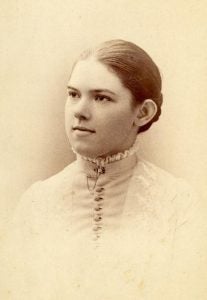
Mary Louise Hinsdale was born on February 24, 1866 to Burke A. Hinsdale and Mary E. Turner. Little is written on her early life, but throughout her adult career she appeared to take great inspiration from her father’s personality and vocation. In her autobiography, she describes Burke Hinsdale as a person who died due to “overwork,” and who juggled numerous taxing responsibilities as a “district school teacher, college professor, college president, minister, editor, lecturer, writer, campaign speaker, and superintendent of a large system of city schools.” Most notably, he was a historian who enjoyed a friendly relationship with James Garfield, whom he met while working at Hiram College, Ohio.[1] Mary, along with her sisters Ellen and Mildred Hinsdale, went on to follow in her father’s footsteps, becoming hardworking historians, and, in Mary’s case, also a professor and educational administrator. While working on her magnum opus, A History of the President’s Cabinet, she even made efforts to preserve her father’s legacy by successfully petitioning to have the correspondence between her father and President Garfield placed in the Library of Congress.[2]
After graduating from Adelbert College of Western Reserve University in 1885, Mary Hinsdale pursued graduate work at Radcliffe and at the University of Michigan, ultimately earning her PhD from the University of Michigan in 1912. As a student, she was assiduous and knowledgeable, to the degree that the professors on the committee of her doctoral exam were not only impressed, but intimidated by the scope of her knowledge on the presidency of the United States. One of her examiners went on to say, “[S]he began to ask us questions which we could not answer. I looked to see whether I could gracefully get out of the room, but Miss Mary was between the door and me. Then I looked out the window and found [another examiner] Arthur Cross was already climbing out.”[3] She had published her History of the President’s Cabinet just the year before, and was told quite correctly by Albert Bushnell Hart of the Harvard University Department of Government that she had “prepared what is undoubtedly going to be the standard work upon the subject for a great many years.”[4]
Following her doctorate, Mary Hinsdale became a faculty member at the Grand Rapids Junior College, where she would continue to work until her retirement. She was as talented a teacher as she was a student and historian, leaving such a lasting impression that in her last month of life, her former student Fred G. Walesett wrote to her praising her “forthrightness, intellectual enthusiasm, and unaffected use of learning” as a professor. He went on to credit her for instilling a “strong idealism” for a love of learning in his later career.[5]
Mary also had numerous tangible markers of her prowess as an educator. By 1928, she had become a historian of such note that the Russian Commissariat of Education selected her as a member of a party of American educators to represent Michigan. Her work in international relations led to her being chosen to lecture in the Universities of Zurich and Geneva. In 1929, she was given a certificate for her active membership the in the National Education Association as a “recognized leader of education in the United States.”[6] In 1937, she was awarded an honorary doctorate from Olivet College for “promoting the best interests of education.” She was further described as a person with a “distinguished mind, warm heart, and flashing humor.”[7]
Mary Hinsdale died at the age of eighty on May 23, 1946. Her life work and efforts as a historian and educator led to the University of Michigan commemorating her in the name of a scholarship, and later, a house within Alice Lloyd Hall. Yet her greatest legacy may in the way she influenced the hearts and minds of the people around her–something for which no medal or certificate exists. As Edward Benson of Grand Rapids College once told her of her work towards promoting international relations and peace During World War II, she may not get recognition “in the form of a scroll or a bronze or silver medal but it is nevertheless engraved in the minds and hearts of all of us who know you.”[8]
Notes:
- Memorial Pamphlet for Burk A. Hinsdale, Miscellaneous Papers, Box 2, Hinsdale Family Papers.
- Mary Hinsdale biography, Miscellaneous Papers, ibid.
- Miss Mary Hinsdale’s Doctoral Exam, 8 October 1849, Correspondence 1901-1946, ibid.
- Letter fromAlbert Bushnell Hart, 29 November 1911, Correspondence 1901-1946, ibid.
- Letter from Fred G. Walestt, 11 April 1946, Correspondence 1901-1946, ibid.
- National Education Association certificate, 1929, Miscellaneous Papers, ibid.
- Honorary Doctorate from Olivet College, 1937, Miscellaneous Papers, ibid.
- Letter from Edward H. Benson, 16 August 1945, Correspondence 1901-1946, ibid.
Image Credit:
Mary Hinsdale, graduation portrait, ca. 1885, J. H. Ryder’s Portraits, Hinsdale Family Papers.



